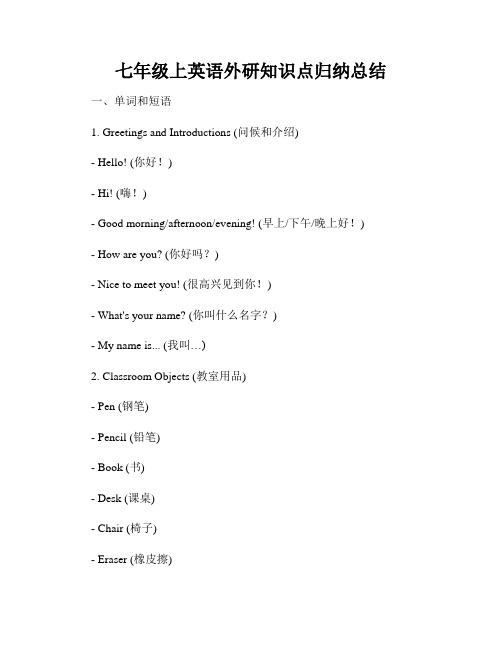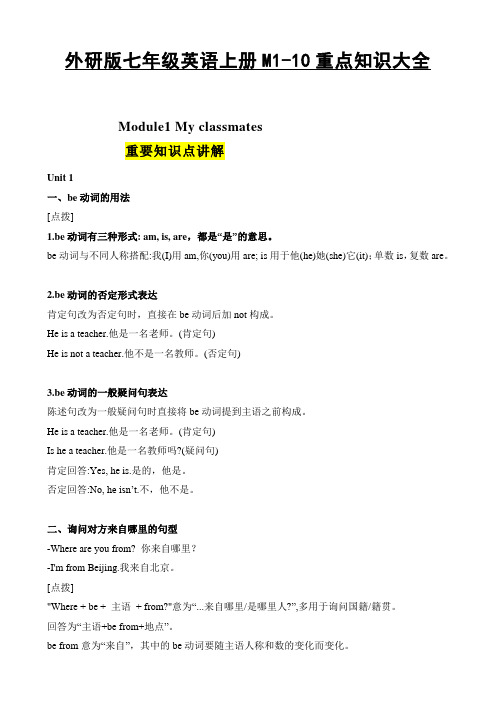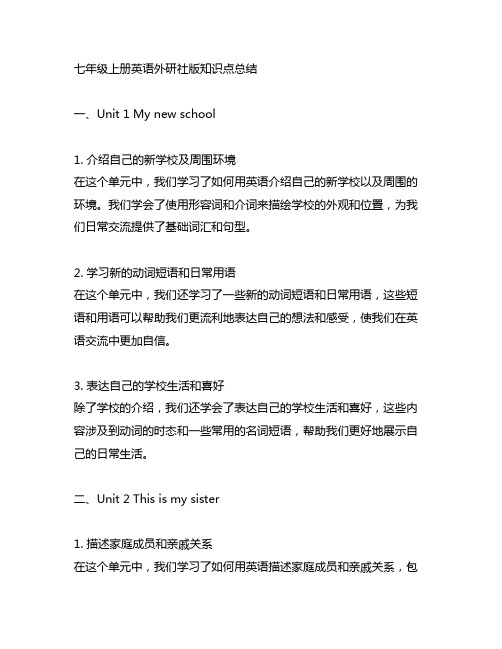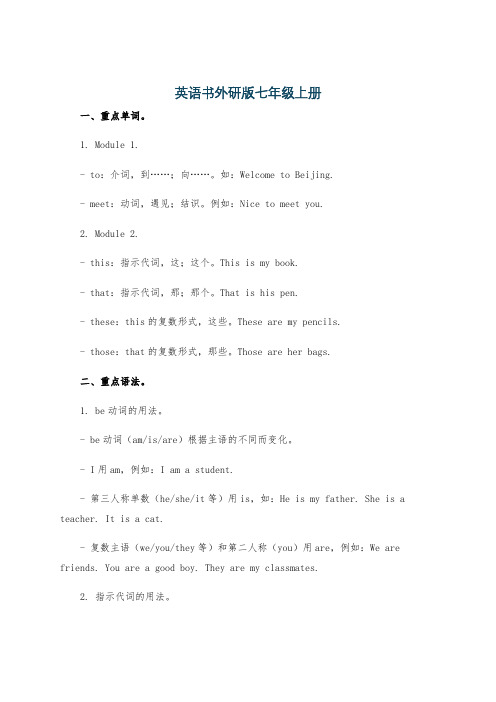外研版七年级英语上册全部知识点
七年级上英语外研知识点归纳总结

七年级上英语外研知识点归纳总结一、单词和短语1. Greetings and Introductions (问候和介绍)- Hello! (你好!)- Hi! (嗨!)- Good morning/afternoon/evening! (早上/下午/晚上好!)- How are you? (你好吗?)- Nice to meet you! (很高兴见到你!)- What's your name? (你叫什么名字?)- My name is... (我叫…)2. Classroom Objects (教室用品)- Pen (钢笔)- Pencil (铅笔)- Book (书)- Desk (课桌)- Chair (椅子)- Eraser (橡皮擦)- Ruler (尺子)- Bag (书包)3. Numbers (数字)- Zero (零)- One (一)- Two (二)- Three (三)- Four (四)- Five (五)- Six (六)- Seven (七)- Eight (八)- Nine (九)- Ten (十)4. Days of the Week (星期) - Monday (星期一)- Tuesday (星期二)- Wednesday (星期三)- Thursday (星期四)- Friday (星期五)- Saturday (星期六)- Sunday (星期日)5. Family Members (家庭成员) - Mother (妈妈)- Father (爸爸)- Brother (哥哥/弟弟)- Sister (姐姐/妹妹)6. Colors (颜色)- Red (红色)- Blue (蓝色)- Yellow (黄色)- Green (绿色)- Orange (橙色)- Purple (紫色)- Black (黑色)- White (白色)二、语法知识点1. 一般现在时- 表示经常性或习惯性的动作或状态。
外研版英语七年级上册复习资料

Module1Module2I.重点短语:I.重点短语:1.befrom...=comefrom...1.来自......1.aphotoofTony’sfamily1.一XTony的家庭的照片2....yearsold2.......岁2.ontheleftof.....2.在......的左边3.whatabout...=howabout...3.......怎么样?3.nextto.....3.紧挨着.....;紧靠......4.inClassTen,GradeSeven4.在七年级十班4.infrontof......4.在......前面〔分开〕5.thecapitalof...5......的首都/省会in/atthefrontof......在......前面〔没有分开〕6.firstname=givenname6.名5.Tony’sparents5.Tony的父母stname=familyname7.姓6.inthephoto6.照片上8.Englishname8.英文名字7.atthebusstation7.在公共车站9.Chinesename9.中文名字8.atapolicestation8.在警察局II.重点句子:9.amanagerofatheater9.一位剧院负责人1.I’mChinese,andI’mfrom1.我是中国人,我来自中国.=atheatermanagerChina.10.amanagerofahotel10.一位宾馆经理(I’mChinese,andIcome2.他们来自什么哪里?=ahotelmanagerfromChina.)11.at/inthesamehospital11.在同一家医院他们来自美国.2.Wherearetheyfrom?12.abusdriver12.一位公共汽车司机(=Wheredotheycome13.afarmworker13.一位农场工人from?)14.ashopworker14.一名店员TheyarefromAmerica.15.anEnglishteacher15.一位英语教师(=TheycomefromII.重点句子:America.)1.ThisisaphotoofTony’s1.这是Tony的一X全家福。
外研版七年级英语上册M1-10重点知识大全

外研版七年级英语上册M1-10重点知识大全Module1 My classmates重要知识点讲解Unit 1一、be动词的用法[点拨]1.be动词有三种形式: am, is, are,都是“是”的意思。
be动词与不同人称搭配:我(I)用am,你(you)用are; is用于他(he)她(she)它(it);单数is,复数are。
2.be动词的否定形式表达肯定句改为否定句时,直接在be动词后加not构成。
He is a teacher.他是一名老师。
(肯定句)He is not a teacher.他不是一名教师。
(否定句)3.be动词的一般疑问句表达陈述句改为一般疑问句时直接将be动词提到主语之前构成。
He is a teacher.他是一名老师。
(肯定句)Is he a teacher.他是一名教师吗?(疑问句)肯定回答:Yes, he is.是的,他是。
否定回答:No, he isn’t.不,他不是。
二、询问对方来自哪里的句型-Where are you from? 你来自哪里?-I'm from Beijing.我来自北京。
[点拨]"Where + be + 主语+ from?"意为“...来自哪里/是哪里人?”,多用于询问国籍/籍贯。
回答为“主语+be from+地点”。
be from意为“来自”,其中的be动词要随主语人称和数的变化而变化。
三、用于确定对方国籍的句型-Hi, are you English too?嘿,你也是英国人吗?-No, I’m not. I’m American and my name is Betty King. 不,我不是。
我是美国人,我叫贝蒂·金。
[点拨]"Are you+国籍?"通常在没有把握确定对方国籍时用此句型。
该句是一般疑问句,肯定回答用“Yes,I am.”否定回答用“No,I'm not.”。
2024外研版英语七年级上册复习知识点汇总

七年级上Revision of Starter 一、重点短语sit down坐下stand up站起来how old多大after school/class放学后/下课后listen to music听音乐welcome to+地点欢迎来某地in English用英语say that again再说一遍of course当然what color什么颜色eve,yday life每天的生活good idea好主意how many/how much多少thank you/thanks谢谢put up sb's hand举起某人的手telephone number电话号码write it on the blackboard把它写在黑板上play basketball/football打篮球/踢足球in Class Five Grade One在一年级五班see you tomorrow明天见go swimming去游泳m+国家/城市等在国家/城市等at+车站/学校/家等在车站/学校/家等sb's favorite sport/color某人最喜欢的运动/颜色good morning/afternoon/evening早上好/下午好/晚上好二、重点句型l---\邓at's your name, please? 请问你叫什么名字?---I'm/My mane's... 我叫.2.---How are you ? 你好吗?---F ine,thanks.很好,谢谢……..in spring/summer/autumn/winter在春/夏/秋/冬等3.---This is my friend/teacher, and his/her name is/he is...这是我的朋友/老师,他的名字是.4.---I t's time to go now. Goodbye.现在该走了,再见。
七年级上册英语外研社版知识点总结

七年级上册英语外研社版知识点总结一、Unit 1 My new school1. 介绍自己的新学校及周围环境在这个单元中,我们学习了如何用英语介绍自己的新学校以及周围的环境。
我们学会了使用形容词和介词来描绘学校的外观和位置,为我们日常交流提供了基础词汇和句型。
2. 学习新的动词短语和日常用语在这个单元中,我们还学习了一些新的动词短语和日常用语,这些短语和用语可以帮助我们更流利地表达自己的想法和感受,使我们在英语交流中更加自信。
3. 表达自己的学校生活和喜好除了学校的介绍,我们还学会了表达自己的学校生活和喜好,这些内容涉及到动词的时态和一些常用的名词短语,帮助我们更好地展示自己的日常生活。
二、Unit 2 This is my sister1. 描述家庭成员和亲戚关系在这个单元中,我们学习了如何用英语描述家庭成员和亲戚关系,包括使用人称代词和家庭成员的称呼,让我们能够更好地向别人介绍自己的家庭。
2. 表达自己的爱好和特长我们还学习了如何用英语表达自己的爱好和特长,这些内容涉及到一些常见的动词和名词,为我们展示自己的个性提供了更多的表达方式。
3. 学习新的动词和形容词在这个单元中,我们也学习了一些新的动词和形容词,这些词汇可以帮助我们更准确地描述自己和家人,让我们的表达更加生动和有趣。
三、Unit 3 Is this your pencil?1. 学习和巩固物品的名称在这个单元中,我们学习了一些日常用品的英文名称,包括文具、衣物等,这些词汇是我们日常生活中必不可少的,掌握了这些词汇可以让我们在购物和交流中更加得心应手。
2. 学习特殊疑问句除了学习物品的名称,我们还学习了如何用特殊疑问句来询问别人是否拥有某样物品,这也为我们以后的交流提供了更多的句型结构。
3. 学习并掌握新的介词和代词在这个单元中,我们还学习了一些新的介词和代词,这些词汇的掌握可以让我们更准确地描述物品的位置和归属,提高我们的口语表达能力。
英语书外研版七年级上册

英语书外研版七年级上册一、重点单词。
1. Module 1.- to:介词,到……;向……。
如:Welcome to Beijing.- meet:动词,遇见;结识。
例如:Nice to meet you.2. Module 2.- this:指示代词,这;这个。
This is my book.- that:指示代词,那;那个。
That is his pen.- these:this的复数形式,这些。
These are my pencils.- those:that的复数形式,那些。
Those are her bags.二、重点语法。
1. be动词的用法。
- be动词(am/is/are)根据主语的不同而变化。
- I用am,例如:I am a student.- 第三人称单数(he/she/it等)用is,如:He is my father. She is a teacher. It is a cat.- 复数主语(we/you/they等)和第二人称(you)用are,例如:We are friends. You are a good boy. They are my classmates.2. 指示代词的用法。
- this和these用来指离说话人较近的人或事物;that和those用来指离说话人较远的人或事物。
- 在回答this/that的问句时,要用it代替;回答these/those的问句时,要用they代替。
例如:- What's this? It's a book.- What are those? They are pens.三、课文解析(以Module 1 Unit 1为例)1. 课文内容。
- “Hello, class. My name's Miss Zhou. Nice to meet you.”- 这是老师在课堂上的自我介绍,“Nice to meet you”是初次见面时常用的礼貌用语。
七年级上册英语版外研版

七年级上册英语版外研版一、单词部分。
1. 重点单词汇总。
- Module 1.- to:介词,常用于表示方向或目的等。
如:Welcome to Beijing.(欢迎来到北京。
)- meet:动词,遇见;结识。
I'm glad to meet you.(很高兴见到你。
)- Module 2.- this:代词,这个。
This is my book.(这是我的书。
)- pencil:名词,铅笔。
I have a new pencil.(我有一支新铅笔。
)- pen:名词,钢笔。
His pen is black.(他的钢笔是黑色的。
)2. 单词记忆方法。
- 联想记忆法。
- 例如记忆“pencil”,可以联想到“pencils are used for writing”(铅笔是用来写字的),通过这种方式将单词和它的用途联系起来,更容易记忆。
- 分类记忆法。
- 把单词按照词性分类,如名词类(book, pen, desk等),动词类(run, jump, meet等),形容词类(nice, big, small等)。
这样在记忆时可以系统地掌握单词的特点。
二、语法部分。
1. 一般现在时。
- 概念:表示经常发生的动作或存在的状态。
- 结构:- 主语为第三人称单数(he/she/it等)时,动词要用第三人称单数形式(一般在动词原形后加 -s或 -es)。
例如:He likes reading books.(他喜欢读书。
)- 主语为第一人称(I)、第二人称(you)和复数(we/they等)时,动词用原形。
如:We play football every day.(我们每天踢足球。
)- 用法:- 表示习惯性、经常性的动作。
例如:I get up at six o'clock every morning.(我每天早上六点起床。
)- 表示客观事实或真理。
The earth goes around the sun.(地球绕着太阳转。
七年级上外研社版英语一到五单元语法知识点

七年级上外研社版英语一到五单元语法知识点一、名词1. 名词的分类名词可以分为可数名词和不可数名词两大类。
可数名词可以用来表示可以数清的事物或东西,比如book、student等。
不可数名词则表示不可以数清的事物或东西,比如water、rice等。
2. 可数名词复数形式的变化可数名词的复数形式有三种变化规则:一般在词尾加-s,如books;以s,sh,ch,x,o结尾的名词在词尾加-es,如buses,watches;以辅音字母+y结尾的名词,变y为i再加-es,如cities。
3. 不可数名词的使用不可数名词表示不能数清的事物,通常用作集体名词,表示一类事物,比如food、music等。
二、动词1. 动词的时态英语中的动词有多种不同的时态,例如现在时、过去时、将来时等。
学生需要掌握各种时态的构成和用法,如一般现在时用于表示现在或经常发生的动作,一般过去时用于表示过去发生的动作等。
2. 动词的否定形式英语中的动词否定形式通常在动词前加not构成,例如I am not happy。
3. 动词的被动语态动词的被动语态表示动作的承受者是谁,被动语态的构成是由“be + 过去分词”构成,如The book is read by me.三、形容词与副词1. 形容词的比较级与最高级形容词的比较级和最高级构成规则较多,主要包括一般形容词和部分双音节形容词的比较级在词尾加-er,最高级在词尾加-est;以不规则变化的形容词则需特殊学习,如good-better-best。
2. 副词的用法副词主要用来修饰动词、形容词或其他副词,表示程度、时间、地点或方式等。
学生需要掌握副词的用法和位置,如修饰动词时通常位于动词之前,修饰形容词或副词时通常位于其后。
四、介词1. 介词的用法介词用来表示名词或代词与其他词之间的关系,如位置、方向、时间、原因等。
学生需要掌握各种介词的用法,如in表示在……之内,on表示在……之上等。
2. 介词短语的用法介词短语是构成形式固定的词组,由介词和名词、代词或动名词构成。
- 1、下载文档前请自行甄别文档内容的完整性,平台不提供额外的编辑、内容补充、找答案等附加服务。
- 2、"仅部分预览"的文档,不可在线预览部分如存在完整性等问题,可反馈申请退款(可完整预览的文档不适用该条件!)。
- 3、如文档侵犯您的权益,请联系客服反馈,我们会尽快为您处理(人工客服工作时间:9:00-18:30)。
外研版七年级英语上册全部知识点In Module 1 of the 7th grade textbook。
we learn about our XXX.Firstly。
we learn about the usage of the verb "be." "Am" is used after the first-person pronoun "I," "is" is used after the third-person singular pronoun。
and "are" is used after the second-person pronoun "you" and all other XXX is "I am。
you are。
he/she/it is。
we/they are."Next。
we learn about how to turn XXX。
For the verb "be," we can simply add the subject after the verb。
For example。
"Are you a student?" For modal verbs like "can," we add the modal verb before the subject and the base form of the main verb after。
For example。
"Can you speak English?" For auxiliary verbs like "do," "does," and "did," we add the auxiliary before the subject and the base form of the main verb after。
For example。
"Do you like English?"We also learn about personal pronouns。
which have different forms for the subject and object cases。
For example。
"I" is the subject form and "me" is the object form。
Possessive pronouns also have different forms for adjective and noun use。
such as "my book" and "mine."In terms of social English。
we learn how to introduce ourselves and ask basic ns like name。
origin。
and age。
We also learn how to XXX.Finally。
XXX on the word "Chinese," which can refer to the Chinese language。
Chinese people。
or something related to China。
It can be used as a XXX.I am a student from China。
As a Chinese student。
I am XXX the world.What do you think about listening to some music。
How about some apples。
These are some ns I would like to offer.ItXXX.e to China。
You are e here。
These are ways to XXX.Thank you。
You are e。
These are polite phrases to use when expressing gratitude.In English。
the first name comes before the last name。
while in China。
the last name comes before the first name。
There may also be a middle name in een.I am a student。
too。
This means that I also fit into the category of being a student。
The word "too" is often used at the end of a sentence。
XXX.The room is too small。
This means that the room is too small and cannot modate what is needed。
"Too" is used to modify adjectives or adverbs in their original form.In expressing a class and grade。
the class is ned first and then the grade。
with both "class" and "grade" capitalized。
For example。
"I'm in Class 1 Grade 2."Module 2: My Family for Grade 7 (Part 1)Grammar Knowledge1.Demonstrative Pronouns1) "This/these" means "this/these" and refers to people or things that are closer to the speaker in time or space。
For example。
"This is my bike" or "These bikes are XXX."2) "That/those" means "that/those" and refers to people or things that are farther from the speaker in time or space。
For example。
"That is his book" or "Those books are his."2.Possessive NounsXXX: (1) Add "'s" after a noun (usually used for living things)。
For example。
"These are Tom's books."2) Add "of" before a noun (usually used for non-living things)。
For example。
"I like the color of the desk."a) For singular or XXX "s," add only "'" at the end of the word。
without adding "s." For example。
"This is Thomas' room" or "These are the students' books."b) For plural nouns not ending in "s," add "'s" at the end of the word。
For example。
"Today is Children's Day."c) When two or more things share ownership。
only use the possessive form after the last noun。
However。
when two or more things have separate ownership。
use the possessive form after each noun。
For example。
"This is Jim and Tom's book" or "These are Jim's and Tom's desks."d) When using both "'s" possessive and "of" possessive together。
it is called "double possessive." There are two ways to form this: "of" + noun possessive or "of" + pronoun possessive。
For example。
"He is a friend of my father's" or "She is a friend of mine."e) The word representing a place or n is often omitted after "'s" possessive。
For example。
"He often goes to his uncle's."Social ns1.确认身份的句型:Is this your mother?Yes。
